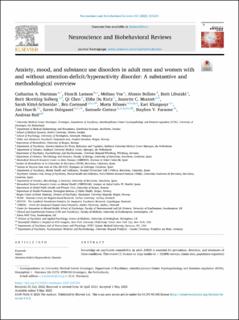| dc.contributor.author | Hartman, Catharina A. | |
| dc.contributor.author | Larsson, Henrik | |
| dc.contributor.author | Vos, Melissa | |
| dc.contributor.author | Bellato, Alessio | |
| dc.contributor.author | Libutzki, Berit | |
| dc.contributor.author | Solberg, Berit Skretting | |
| dc.contributor.author | Chen, Qi | |
| dc.contributor.author | Du Rietz, Ebba | |
| dc.contributor.author | Mostert, Jeanette C. | |
| dc.contributor.author | Kittel-Schneider, Sarah | |
| dc.contributor.author | Cormand, Bru | |
| dc.contributor.author | Ribasés, Marta | |
| dc.contributor.author | Klungsøyr, Kari | |
| dc.contributor.author | Haavik, Jan | |
| dc.contributor.author | Dalsgaard, Søren | |
| dc.contributor.author | Cortese, Samuele | |
| dc.contributor.author | Faraone, Stephen | |
| dc.contributor.author | Reif, Andreas | |
| dc.date.accessioned | 2023-06-13T12:48:59Z | |
| dc.date.available | 2023-06-13T12:48:59Z | |
| dc.date.created | 2023-06-01T13:22:26Z | |
| dc.date.issued | 2023 | |
| dc.identifier.issn | 0149-7634 | |
| dc.identifier.uri | https://hdl.handle.net/11250/3071178 | |
| dc.description.abstract | Knowledge on psychiatric comorbidity in adult ADHD is essential for prevention, detection, and treatment of these conditions. This review (1) focuses on large studies (n > 10,000; surveys, claims data, population registries) to identify (a) overall, (b) sex- and (c) age-specific patterns of comorbidity of anxiety disorders (ADs), major depressive disorder (MDD), bipolar disorder (BD) and substance use disorders (SUDs) in adults with ADHD relative to adults without ADHD; and (2) describes methodological challenges relating to establishing comorbidity in ADHD in adults as well as priorities for future research. Meta-analyses (ADHD: n = 550,748; no ADHD n = 14,546,814) yielded pooled odds ratios of 5.0(CI:3.29–7.46) for ADs, 4.5(CI:2.44–8.34) for MDD, 8.7(CI:5.47–13.89) for BD and 4.6(CI:2.72–7.80) for SUDs, indicating strong differences in adults with compared to adults without ADHD. Moderation by sex was not found: high comorbidity held for both men and women with sex-specific patterns as in the general population: higher prevalences of ADs, MDD and BD in women and a higher prevalence of SUDs in men. Insufficient data on different phases of the adult lifespan prevented conclusions on developmental changes in comorbidity. We discuss methodological challenges, knowledge gaps, and future research priorities. | en_US |
| dc.language.iso | eng | en_US |
| dc.publisher | Elsevier | en_US |
| dc.rights | Attribution-NonCommercial-NoDerivatives 4.0 Internasjonal | * |
| dc.rights.uri | http://creativecommons.org/licenses/by-nc-nd/4.0/deed.no | * |
| dc.title | Anxiety, mood, and substance use disorders in adult men and women with and without attention-deficit/hyperactivity disorder: A substantive and methodological overview | en_US |
| dc.type | Journal article | en_US |
| dc.type | Peer reviewed | en_US |
| dc.description.version | publishedVersion | en_US |
| dc.rights.holder | Copyright 2023 The Author(s) | en_US |
| dc.source.articlenumber | 105209 | en_US |
| cristin.ispublished | true | |
| cristin.fulltext | original | |
| cristin.qualitycode | 2 | |
| dc.identifier.doi | 10.1016/j.neubiorev.2023.105209 | |
| dc.identifier.cristin | 2150835 | |
| dc.source.journal | Neuroscience and Biobehavioral Reviews | en_US |
| dc.relation.project | EU – Horisont Europa (EC/HEU): 667302 | en_US |
| dc.relation.project | EU – Horisont Europa (EC/HEU): 728018 | en_US |
| dc.relation.project | EU – Horisont Europa (EC/HEU): 965381 | en_US |
| dc.identifier.citation | Neuroscience and Biobehavioral Reviews. 2023, 151, 105209. | en_US |
| dc.source.volume | 151 | en_US |

